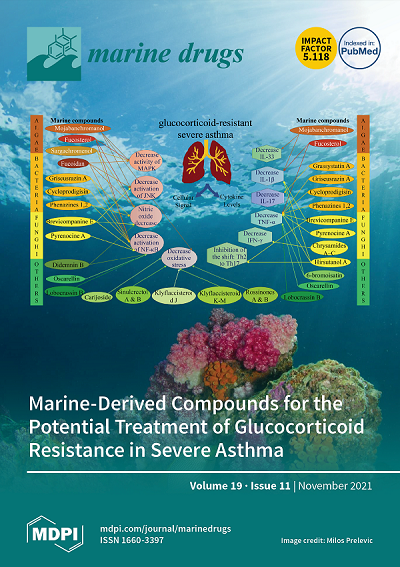机器学习驱动的巨钳鱼粘液蛋白质组抗菌肽的发现与评估
IF 4.9
2区 医学
Q1 CHEMISTRY, MEDICINAL
引用次数: 0
摘要
海洋抗菌肽(AMPs)是抗感染(尤其是抗生素耐药病原体和传统上具有挑战性的感染)的一个前景广阔的来源。然而,传统的药物发现方法面临着耗时长、成本高的挑战。因此,利用机器学习技术加快海洋 AMPs 的发现大有可为。我们的研究将机器学习应用于开发海洋 AMPs,重点是富含抗菌成分的巨尾鳕粘液。我们对巨钳鱼粘液蛋白进行了蛋白质组测序,使用 iAMPCN 模型进行了多肽活性预测,并评估了六种多肽的抗菌、溶血和细胞毒性能力。蛋白质组分析确定了 4490 个蛋白质,产生了约 43,000 个多肽(8-50 个氨基酸)。根据长度、疏水性和电荷对肽进行排序,评估其抗菌潜力,预测出 23 种生物活性。其中六种肽具有较高的相对分数和较好的生物活性,被选中进行杀菌试验。多肽 P1 至 P4 对大肠杆菌具有抗菌活性,其中 P2 和 P4 尤为有效。所有肽都能抑制金黄色葡萄球菌的生长。P2 和 P4 还具有显著的抗副溶血病毒作用,而 P1 和 P3 在可检测浓度下对 HEK293T 细胞无毒性。即使在高浓度下,也能观察到所有肽具有最小的溶血活性。这项研究突出了天然牡蛎粘液肽的强效抗菌特性,强调了它们的低细胞毒性和无溶血作用。机器学习准确预测了生物活性,展示了其在多肽药物发现方面的潜力。本文章由计算机程序翻译,如有差异,请以英文原文为准。
Machine Learning-Driven Discovery and Evaluation of Antimicrobial Peptides from Crassostrea gigas Mucus Proteome
Marine antimicrobial peptides (AMPs) represent a promising source for combating infections, especially against antibiotic-resistant pathogens and traditionally challenging infections. However, traditional drug discovery methods face challenges such as time-consuming processes and high costs. Therefore, leveraging machine learning techniques to expedite the discovery of marine AMPs holds significant promise. Our study applies machine learning to develop marine AMPs, focusing on Crassostrea gigas mucus rich in antimicrobial components. We conducted proteome sequencing of C. gigas mucous proteins, used the iAMPCN model for peptide activity prediction, and evaluated the antimicrobial, hemolytic, and cytotoxic capabilities of six peptides. Proteomic analysis identified 4490 proteins, yielding about 43,000 peptides (8–50 amino acids). Peptide ranking based on length, hydrophobicity, and charge assessed antimicrobial potential, predicting 23 biological activities. Six peptides, distinguished by their high relative scores and promising biological activities, were chosen for bactericidal assay. Peptides P1 to P4 showed antimicrobial activity against E. coli, with P2 and P4 being particularly effective. All peptides inhibited S. aureus growth. P2 and P4 also exhibited significant anti-V. parahaemolyticus effects, while P1 and P3 were non-cytotoxic to HEK293T cells at detectable concentrations. Minimal hemolytic activity was observed for all peptides even at high concentrations. This study highlights the potent antimicrobial properties of naturally occurring oyster mucus peptides, emphasizing their low cytotoxicity and lack of hemolytic effects. Machine learning accurately predicted biological activity, showcasing its potential in peptide drug discovery.
求助全文
通过发布文献求助,成功后即可免费获取论文全文。
去求助
来源期刊

Marine Drugs
医学-医药化学
CiteScore
9.60
自引率
14.80%
发文量
671
审稿时长
1 months
期刊介绍:
Marine Drugs (ISSN 1660-3397) publishes reviews, regular research papers and short notes on the research, development and production of drugs from the sea. Our aim is to encourage scientists to publish their experimental and theoretical research in as much detail as possible, particularly synthetic procedures and characterization information for bioactive compounds. There is no restriction on the length of the experimental section.
 求助内容:
求助内容: 应助结果提醒方式:
应助结果提醒方式:


